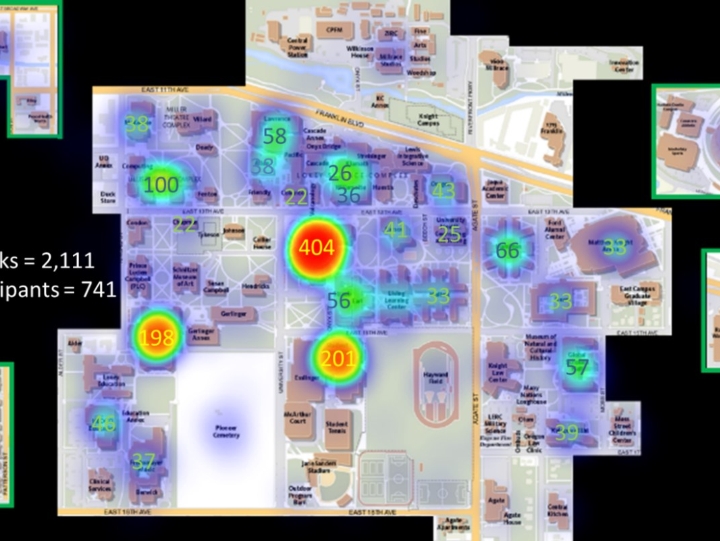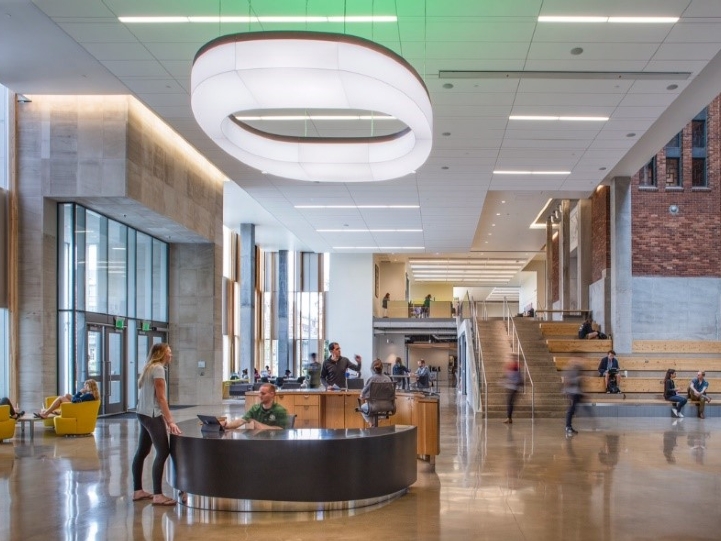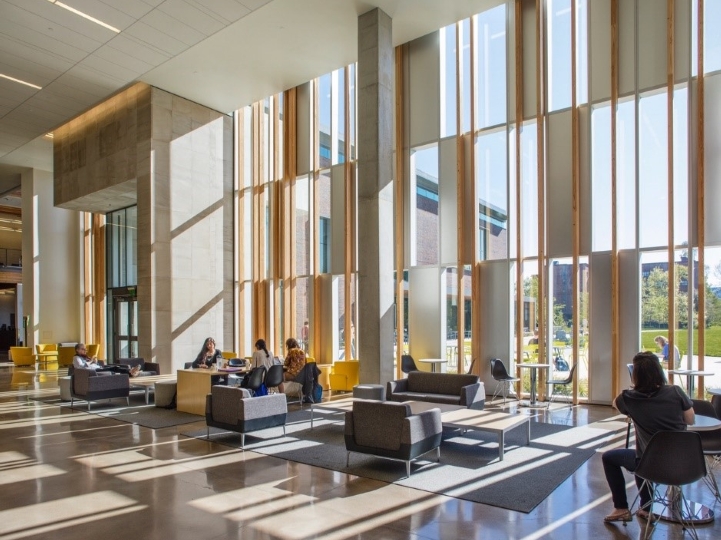Hot Spots Matter: Framing Place-based Sense of Belonging
Health, Safety, and Well-being Student Success Assessment, Evaluation, and Research
November 21, 2019
The recently-renovated Erb Memorial Union (EMU) is the heart of our campus. No University of Oregon (UO) graduate has ever majored in student unions, but it would be hard to find a Duck whose college experience wasn’t shaped by the EMU. Since it first opened in 1950, the EMU has provided a place to study, eat, and gather. And as a residential campus, our student union is more than that. It is a vital part of our university’s vision to create a vibrant community of scholars.
Through our Student Wellbeing and Success Initiative (SWaSI) research program, the Office of Assessment & Research (OAR) within the Division of Student Life has been exploring place-based belonging, the idea that people’s affinity for physical places, or lack thereof, is intertwined with their sense of whether or not they fit in socially. Borrowing from Pitcher and colleagues to get at this affinity, we ask undergraduate students to click up to three places on a campus map where they feel like they “belong, fit in, are connected, are accepted, etc.,” and separately, to click up to three places where they feel like they “do not belong, do not fit it, are disconnected, are not accepted, etc.” For the last two academic years, students have chosen the EMU as the number one place on campus where they feel like they belong.
The heat map in Figure 1 was produced in Qualtrics. The larger and redder the area, the more it was clicked. Regions were redrawn on the maps to disaggregate places and to cover the vast majority of campus, including outdoor areas. The Erb Memorial Union (n = 404) had the highest click count, the Student Recreation Center (n = 201) had the second highest click count, and the Knight Library (n = 198) had the third largest.
Figure 1. Where Students Felt Like they Belong on the University of Oregon Campus in 2019

Note: Participant is defined as a student who clicked at least once on the map. Students included in data collection spanned first-years to fourth-years (2015-16, 2016-17, 2017-18, 2018-19 cohorts).
Further, because we ask students where they feel like they do and do not belong, we can compute a metric representing overall inclusiveness. That is, a place is inclusive to the extent its “belong” click count is high and its “don’t belong” click count is low. Considering the percent of “belong” clicks out of total clicks among the most clicked campus places, the EMU is by far the most inclusive (84% on average). A fairly distant second, but still solidly inclusive, is the Knight Library (73% on average).
Because of these results, we have been exploring how belonging is experienced at the EMU specifically and have designed an entire research study to understand how students experience the building.
Framing with research
Due to our union’s recent renovation, its importance as a vital part of the UO, and it being identified as the top place on campus where students feel like they belong, we explored use of the building, as well as perception and thoughts on the use of spaces and places that comprise it through a post-occupancy study. This study had three phases: observations of large, key spaces; a survey measuring belonging and usage; and lastly focus groups. This research helped us gauge how students are experiencing places on campus as well as how well the EMU was functioning and how students were interacting with the place.
Our exploration of place-based belonging began with asking students to write about the places they clicked. Specifically, when students clicked on one of several previously-identified high-click places, they were asked to describe “specifically what” (2018) or “at least one experience” (2019) at the place that made them feel the way they do.

Where on your campus are your hot spots?
EMU Hot Spots…
After selecting places in the EMU through our research, students were asked follow-up questions about those particular places. One follow-up question was an open-ended response prompt: “What specifically about the (selected place) makes it one of your favorites?” Textual data that students generated based on this prompt were analyzed for places that were selected at least 20 times.
Grounded Theory was employed to discover emergent themes, patterns, and trends in the textual data. Forming the basic unit of analysis, open coding was used to create categories that fit the textual data by looking for distinct concepts emerging from responses. On the basis of these initial codes, axial coding was used to confirm that the open codes accurately represent the data and explore how they were related to each other. Students describe the EMU as a welcoming, comfortable, and inclusive social-hub with many resources (eg., Craft Center, Duck Nest, Mills International, Multicultural Center, etc.) where students can meet new and different people, create community, spend time with friends, get food, and do homework while killing time between classes.

UO students generally feel like they belong at the EMU because it provides open, public places, which makes sense given their versatility. They provide unstructured environments, not just for socializing, but other activities (e.g., study, eat, sleep, etc.). Many identity-related centers popped up high on the ‘favorite’ list for students along with resource centers (e.g., Computer Lab, Center for Student Involvement), though the Women’s Center was notably absent. Other additions to the list were a smattering of comfortable nooks (the 2nd floor study tables, the McMillan Gallery, and the Student Lounge), a couple of event places (the Ballroom and the Redwood Auditorium), and a purely food/beverage-related places (e.g., Starbucks, Fresh Market Corner, etc.). Social reasons for places being favorites were common, however the most common reasons were actually those pertaining to physical environment, from the design of windows leveraging natural lighting to the furniture to ambient sounds.
Hot Spots in Action
When it comes to data-informed decision-making, this information has been used in many ways. Validation of the importance of the EMU on our campus and its contribution to providing a positive experience has been critical. Physical features of the environment (e.g., natural lighting, furniture) are reasons that factor into students’ favorite places. It is important for facility planning and maintenance and should motivate continuously reviewing and discussing maintenance resources so that places can maximize positive student experience.
The friendliness of staff was often mentioned in reference to creating a ‘warm’ and ‘welcoming’ environment for students. This should be praised and continued. Planning professional development for staff is critical to ensuring they are engaged with this perspective as it radiates to students in their interactions.
The top favorite places were large, open areas, which suggests that students like to make use of places informally, by themselves and with peers. The balance between implementing structured programming in these areas and leaving them unstructured should be discussed. Too much structure may negatively impact the organic engagement students enjoy in these places. Following, the large spaces, students ranked student-facing, diversity program spaces (e.g., Mills International Center) as places they felt like they belonged. Creating a welcoming community through identity-based spaces is brought to fruition in the EMU and can be a model for the rest of the campus community. In sum, there should be something for everyone in the student union.
All our team members:
- Laurie Woodward, Ph.D., Director, Erb Memorial Union Division of Student Life (lauriew@uoregon.edu)
- Mathieu Wilson, Career Readiness Coach, University Career Center (mathieuw@uoregon.edu)
- Brian Clark, Ph.D., Assistant Director, Office of Assessment and Research, Division of Student Life (clark13@uoregon.edu)
- Renée Delgado-Riley, Ph.D., Director, Office of Assessment and Research, Division of Student Life (reneedr@uoregon.edu)